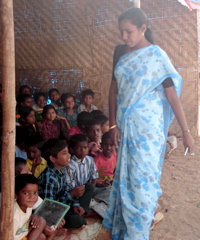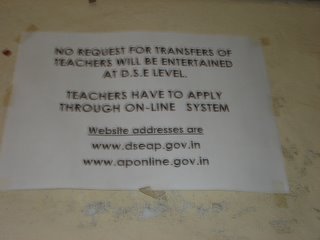 It is pretty funny that the school is still in the cow shed. But even with all the physical challenges, the school just won “Best School” among the cluster of our local schools (Madhapur, Kothaguda, and Chanda Naitana). I wish I could say that all the schools in our cluster were doing OK, but they are really struggling. They do not have a chance to compete with the Rainbow School because they do not have the resources that the Rainbow School has. However, there is more to this than just lack of resources.
It is pretty funny that the school is still in the cow shed. But even with all the physical challenges, the school just won “Best School” among the cluster of our local schools (Madhapur, Kothaguda, and Chanda Naitana). I wish I could say that all the schools in our cluster were doing OK, but they are really struggling. They do not have a chance to compete with the Rainbow School because they do not have the resources that the Rainbow School has. However, there is more to this than just lack of resources.The other week I spent a long day at the Mandal Education Office. A small gathering of bright and shiny teachers was there working in the mandal’s teacher resource room. The room has some chairs, a blackboard, and a table. There are also some old textbooks (paperback) stacked against the wall. There are several big windows with good views of the surrounding country. But there is nothing in the way of “teacher resources.” No charts to take, no stacks of chalk, no blocks or globes or models. Nothing they could take to their schools to use for teaching. The only resource in the room were the teachers themselves. So they talked and talked and talk to each other about their plans and ideas as they waited for the Mandal Education Officer. He finally arrived on his motorcycle. Then they lined up in his bare, dusty office which doesn’t even have a telephone. Each teacher had a request. These were very specific requests for teaching tools like Petri dishes, pencils, or poster boards.
 All the teachers heard in reply was: “NO.” Without looking up or even letting them finish the sentence, he just said NO. Why? Maybe the MEO knew he was due to retire and couldn’t procure their items before he left. Maybe he feared corruption and thought the Petri dishes would just end up sold on the black market (so the teacher would get a few rupees for her family). Maybe if he released funds for these items, a thousand teachers would descend on him to pressure for urgently needed salary increases. Maybe there were unions that would pressure him for *additional* kickbacks if he were caught actively using funds to buy teaching aides. Or, maybe there wasn’t any money left in the budget for teaching supplies? The bright and shiny teachers left. Then the MEO called for tea and we had a chat about funding for the school building.
All the teachers heard in reply was: “NO.” Without looking up or even letting them finish the sentence, he just said NO. Why? Maybe the MEO knew he was due to retire and couldn’t procure their items before he left. Maybe he feared corruption and thought the Petri dishes would just end up sold on the black market (so the teacher would get a few rupees for her family). Maybe if he released funds for these items, a thousand teachers would descend on him to pressure for urgently needed salary increases. Maybe there were unions that would pressure him for *additional* kickbacks if he were caught actively using funds to buy teaching aides. Or, maybe there wasn’t any money left in the budget for teaching supplies? The bright and shiny teachers left. Then the MEO called for tea and we had a chat about funding for the school building.I never got the nerve to ask him why he said no to the teachers, but I am sure it wasn’t because of money. One of my partner organizations reports that 52% of the Central Government funds (from Delhi) sent to the state for use by the government schools was returned by the state of Andhra Pradesh in 2006. My partners believe the problem is with the lowest level of the education department: They just don’t execute. That is what I saw. I do accept that the MEO may have said no out of fear of one of the million forms of corruption that crop up in any place of great scarcity. Regardless, the schools suffer because there is a problem with the execution: doing the job of distributing resources. (See the latest World Bank report for more on this central challenge to India: http://web.worldbank.org/WBSITE/EXTERNAL/COUNTRIES/SOUTHASIAEXT/0,,contentMDK:20980493~pagePK:146736~piPK:146830~theSitePK:223547,00.html)
This is why I support a third-party NGO going into government schools. The pressure is not on an NGO staffer the same way it is on a government employee with a pension at risk. Third-party NGOs can do amazing things to make the suffocated, corrupted Indian bureaucracy work. The Naandi Foundation is saving thousands of government schools from the “MEO Says No” syndrome. (www.naandi.org) And I have to plug Dr. Pat’s wonderful work at the Institute of Rural Health Studies. (www.irhs.org) She saves patients from the “Doctor Says No” syndrome. She creates the same magical effect on the government hospitals to ensure children receive quality medical care. (Going even further, she talks the private hospitals into accepting no-pay patients, too!) Horray Naandi!! Horray Dr. Pat!!
 The final say is that poverty is the root problem. Corruption and extreme scarcity go hand-in-hand. A growing Indian economy will certainly help. But corruption will not go away just because poverty is alleviated. It will most certainly be necessary to have a full-strength legal tool to combat it (For the successful history of combating corruption in Hong Kong and Singapore, see www.info.tdri.or.th/reports/
The final say is that poverty is the root problem. Corruption and extreme scarcity go hand-in-hand. A growing Indian economy will certainly help. But corruption will not go away just because poverty is alleviated. It will most certainly be necessary to have a full-strength legal tool to combat it (For the successful history of combating corruption in Hong Kong and Singapore, see www.info.tdri.or.th/reports/IMPORTANT NOTE: I am happy to report how little corruption I have seen in all my dealings for the school. Not only that, we are surrounded by angels (including Big Government Man, the code name for our true angel in government who came to us thanks to Ravi Raju and Srinivas Reddy). These angels, from our local police inspector to the engineers at the DPEP's office, actively help us with the school with ideas, with funding, by circumventing the more corrupt bureaucrats for us, and by gracing us with good management practices. Also, in the past ten months several posts have turned over and, I am again happy to report, very capable people are now assigned to those posts.
 Yet I can also report, as an immediate by-stander, that partners of mine and other NGO friends are routinely subject to obscenely overt requests for bribes, and/or have politicians squash their projects. They also face bureaucrats blocking approvals until “favors” are done. I fear that if the Rainbow School lost our angels, we would be subject to the same. The students would suffer the most. Corruption does hurt all of us.
Yet I can also report, as an immediate by-stander, that partners of mine and other NGO friends are routinely subject to obscenely overt requests for bribes, and/or have politicians squash their projects. They also face bureaucrats blocking approvals until “favors” are done. I fear that if the Rainbow School lost our angels, we would be subject to the same. The students would suffer the most. Corruption does hurt all of us.
Comments
Post a Comment
Leave a Message